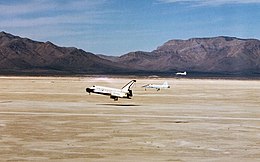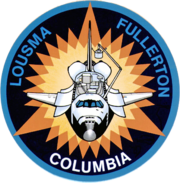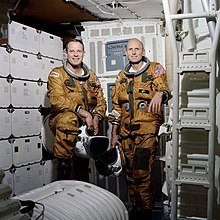
STS-51-F was the 19th flight of NASA's Space Shuttle program and the eighth flight of Space Shuttle Challenger. It launched from Kennedy Space Center, Florida, on July 29, 1985, and landed eight days later on August 6, 1985.

STS-1 was the first orbital spaceflight of NASA's Space Shuttle program. The first orbiter, Columbia, launched on April 12, 1981, and returned on April 14, 1981, 54.5 hours later, having orbited the Earth 37 times. Columbia carried a crew of two—commander John W. Young and pilot Robert L. Crippen. It was the first American crewed space flight since the Apollo–Soyuz Test Project (ASTP) in 1975. STS-1 was also the maiden test flight of a new American spacecraft to carry a crew, though it was preceded by atmospheric testing (ALT) of the orbiter and ground testing of the Space Shuttle system.

STS-9 was the ninth NASA Space Shuttle mission and the sixth mission of the Space Shuttle Columbia. Launched on November 28, 1983, the ten-day mission carried the first Spacelab laboratory module into orbit.

STS-2 was the second Space Shuttle mission conducted by NASA, and the second flight of the orbiter Columbia. The mission, crewed by Joe H. Engle and Richard H. Truly, launched on November 12, 1981, and landed two days later on November 14, 1981. STS-2 marked the first time that a crewed, reusable orbital vehicle returned to space. This mission tested the Shuttle Imaging Radar (SIR) as part of the OSTA-1 payload, along with a wide range of other experiments including the Shuttle robotic arm, commonly known as Canadarm. Other experiments or tests included Shuttle Multispectral Infrared Radiometer, Feature Identification and Location Experiment, Measurement of Air Pollution from Satellites, Ocean Color Experiment, Night/Day optical Survey of Lightning, Heflex Bioengineering Test, and Aerodynamic Coefficient Identification Package (ACIP). One of the feats accomplished was various tests on the Orbital Maneuvring System (OMS) including starting and restarting the engines while in orbit and various adjustments to its orbit. The OMS tests also helped adjust the Shuttle's orbit for use of the radar. During the mission, President Reagan called the crew of STS-2 from Mission Control Center in Houston.
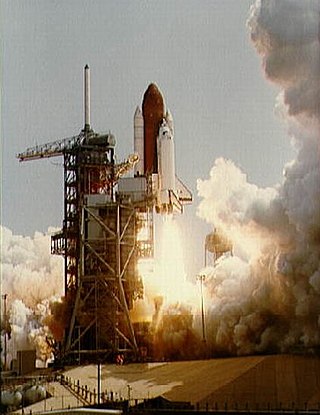
STS-4 was the fourth NASA Space Shuttle mission, and also the fourth for Space Shuttle Columbia. Crewed by Ken Mattingly and Henry Hartsfield, the mission launched on June 27, 1982, and landed a week later on July 4, 1982. Due to parachute malfunctions, the SRBs were not recovered.

STS-5 was the fifth NASA Space Shuttle mission and the fifth flight of the Space Shuttle Columbia. It launched on November 11, 1982, and landed five days later on November 16, 1982. STS-5 was the first Space Shuttle mission to deploy communications satellites into orbit, and the first officially "operational" Space Shuttle mission.

STS-6 was the sixth NASA Space Shuttle mission and the maiden flight of the Space ShuttleChallenger. Launched from Kennedy Space Center on April 4, 1983, the mission deployed the first Tracking and Data Relay Satellite, TDRS-1, into orbit, before landing at Edwards Air Force Base on April 9, 1983. STS-6 was the first Space Shuttle mission during which a Extravehicular activity was conducted, and hence was the first in which the Extravehicular Mobility Unit (EMU) was used.

Robert Laurel Crippen is an American retired naval officer and aviator, test pilot, aerospace engineer, and retired astronaut. He traveled into space four times: as pilot of STS-1 in April 1981, the first Space Shuttle mission; and as commander of STS-7 in June 1983, STS-41-C in April 1984, and STS-41-G in October 1984. He was also a part of the Manned Orbiting Laboratory (MOL), Skylab Medical Experiment Altitude Test (SMEAT), ASTP support crew member, and the Approach and Landing Tests (ALT) for the Space Shuttle.
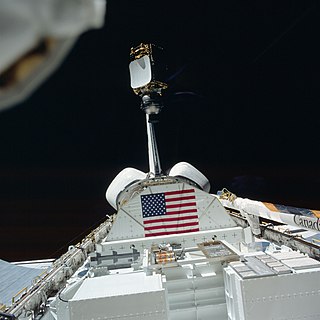
STS-8 was the eighth NASA Space Shuttle mission and the third flight of the Space Shuttle Challenger. It launched on August 30, 1983, and landed on September 5, 1983, conducting the first night launch and night landing of the Space Shuttle program. It also carried the first African-American astronaut, Guion Bluford. The mission successfully achieved all of its planned research objectives, but was marred by the subsequent discovery that a solid-fuel rocket booster had almost malfunctioned catastrophically during the launch.
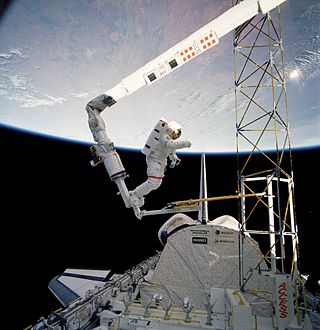
STS-61-B was the 23rd NASA Space Shuttle mission, and its second using Space Shuttle Atlantis. The shuttle was launched from Kennedy Space Center, Florida, on November 26, 1985. During STS-61-B, the shuttle crew deployed three communications satellites, and tested techniques of constructing structures in orbit. Atlantis landed at Edwards Air Force Base, California, at 16:33:49 EST on December 3, 1985, after 6 days, 21 hours, 4 minutes, and 49 seconds in orbit.

STS-61-C was the 24th mission of NASA's Space Shuttle program, and the seventh mission of Space Shuttle Columbia. It was the first time that Columbia, the first space-rated Space Shuttle orbiter to be constructed, had flown since STS-9. The mission launched from Florida's Kennedy Space Center on January 12, 1986, and landed six days later on January 18, 1986. STS-61-C's seven-person crew included the first Costa Rican-born astronaut, Franklin Chang-Díaz, the second African-American shuttle pilot, Charles Bolden, and the second sitting politician to fly in space, Rep. Bill Nelson (D-FL). Both Bolden and Nelson would also later go on to become Administrators of NASA. STS-61-C was the last shuttle mission before the Space Shuttle Challenger disaster, which occurred ten days after STS-61-C's landing.

STS-28 was the 30th NASA Space Shuttle mission, the fourth shuttle mission dedicated to United States Department of Defense (DoD) purposes, and the eighth flight of Space Shuttle Columbia. The mission launched on August 8, 1989, and traveled 3,400,000 km (2,100,000 mi) during 81 orbits of the Earth, before landing on runway 17 of Edwards Air Force Base, California, on August 13, 1989. STS-28 was also Columbia's first flight since January 1986, when it had flown STS-61-C, the mission directly preceding the Challenger disaster of STS-51-L. The mission details of STS-28 are classified, but the payload is widely believed to have been the first SDS-2 relay communications satellite. The altitude of the mission was between 295 km (183 mi) and 307 km (191 mi).

Henry Warren Hartsfield Jr. was a United States Air Force Colonel and NASA astronaut who logged over 480 hours in space. He was inducted into the United States Astronaut Hall of Fame in 2006.

Jack Robert Lousma is an American astronaut, aeronautical engineer, retired United States Marine Corps officer, former naval aviator, NASA astronaut, and politician. He was a member of the second crew, Skylab-3, on the Skylab space station in 1973. In 1982, he commanded STS-3, the third Space Shuttle mission. Lousma was inducted into the United States Astronaut Hall of Fame in 1997. He is the last living crew member of both of his spaceflights.

Charles Gordon Fullerton was a United States Air Force colonel, a USAF and NASA astronaut, and a research pilot at NASA's Dryden Flight Research Facility, Edwards, California. His assignments included a variety of flight research and support activities piloting NASA's B-52 launch aircraft, the Boeing 747 Shuttle Carrier Aircraft (SCA), and other multi-engine and high performance aircraft.

STS-58 was a NASA mission flown by Space Shuttle Columbia launched from Kennedy Space Center, Florida, on October 18, 1993. The missions was primarily devoted to experiments concerning the physiological effects in space. This was the first in-flight use of the "Portable In-flight Landing Operations Trainer" (PILOT) simulation software. It was also the last time Columbia would land at Edwards Air Force Base, California.

The Space Shuttle orbiter is the spaceplane component of the Space Shuttle, a partially reusable orbital spacecraft system that was part of the discontinued Space Shuttle program. Operated from 1981 to 2011 by NASA, the U.S. space agency, this vehicle could carry astronauts and payloads into low Earth orbit, perform in-space operations, then re-enter the atmosphere and land as a glider, returning its crew and any on-board payload to the Earth.

The Approach and Landing Tests were a series of sixteen taxi and flight trials of the prototype Space Shuttle Enterprise that took place between February and October 1977 to test the vehicle's flight characteristics. Of the sixteen taxi-tests and flights, eleven saw Enterprise remain mated to the Shuttle Carrier Aircraft (SCA), while the final five had the shuttle jettisoned from the SCA, with the on-board crew flying and landing the spacecraft.
